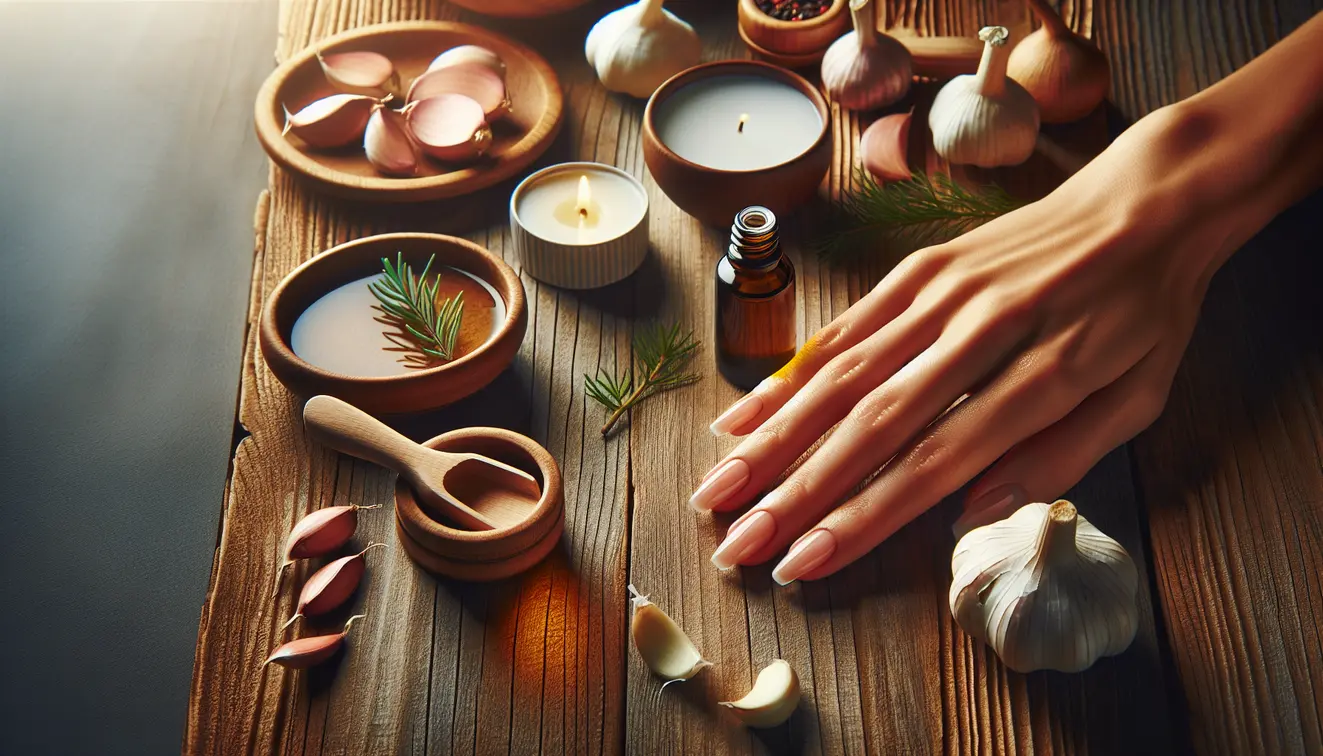Home Remedies for Fungus on Fingernails: Effective Natural Solutions to Try Today
Estimated reading time: 8 minutes
Key Takeaways
- Fingernail fungus, or onychomycosis, is a common condition caused by fungi thriving in warm, moist environments.
- Natural remedies like tea tree oil, apple cider vinegar, and garlic offer budget-friendly, gentle alternatives to tackle early infections.
- Consistency and patience are crucial—results may take 2-6 months due to slow nail growth.
- Proper hygiene and prevention tips can stop fungus from returning after treatment.
- If symptoms worsen or persist, seeking medical help is essential for stubborn cases.
Table of Contents
- Introduction to Fingernail Fungus and Home Remedies
- Understanding Fingernail Fungus: Causes and Symptoms
- Top Evidence-Based Home Remedies for Fingernail Fungus
- How to Apply Home Remedies Safely and Effectively
- Prevention Tips to Avoid Recurrence of Fingernail Fungus
- Limitations of Home Remedies and When to Seek Medical Help
- Frequently Asked Questions (FAQs) About Fingernail Fungus Remedies
Introduction to Fingernail Fungus and Home Remedies
Have you noticed your fingernails turning yellow or becoming thick and brittle? You might be dealing with fingernail fungus, also known as onychomycosis, a common condition caused by tiny fungi invading the nail bed. This pesky issue can affect how your nails look and feel, sometimes leading to discomfort if ignored.
Fungus thrives in warm, moist environments, making fingernails susceptible, especially if they’re often exposed to water. According to the Mayo Clinic, up to 10% of people worldwide deal with this condition, per studies from the National Institutes of Health (NIH). It’s no surprise that many turn to home remedies for help—natural options are often gentle, budget-friendly, and can work alongside medical treatments.
At WikiHomeRemedies, we’re here to guide you through safe and practical solutions rooted in science. Our mission is to empower you with trustworthy information, drawing from reputable sources like WebMD and real-life experiences. This guide will walk you through understanding fingernail fungus and introduce natural remedies you can start using today. Let’s take the first step toward healthier nails together, harnessing the healing power of nature with care and confidence. For more insights on nail health, check out our comprehensive guide on nail fungus remedies.
Understanding Fingernail Fungus: Causes and Symptoms
What Causes Fingernail Fungus?
Fingernail fungus starts when certain types of fungi—dermatophytes, yeast, or molds—find their way under or around your nails. These organisms love warmth and moisture, so damp environments like sweaty gloves or frequent handwashing can invite them in. The infection often spreads through direct contact, such as touching infected surfaces, or by sharing items like nail clippers.
Poor nail care or small cuts near the nail can also open the door to these invaders. Once inside, the fungus feeds on keratin, the protein in your nails, slowly weakening them. Studies from the Cleveland Clinic point out that these conditions are more common in humid climates, something to keep in mind if you’re often in such settings.
Recognizing the Symptoms
How do you know if fungus has taken hold? Look for changes in your nails—yellow or white discoloration often appears first, sometimes with streaks or spots. The nail might thicken, crumble at the edges, or even lift from the nail bed, creating an unpleasant sight.
In more stubborn cases, you might notice a faint odor or feel discomfort when pressing on the nail. These signs can start small but grow over time if untreated. Paying attention to these early warnings can help you act before things get worse.
Risk Factors and Progression
Certain habits or conditions can make you more prone to this issue. Poor hygiene, nail injuries, or wearing tight gloves for long periods can increase your chances—athletes, for instance, often face higher risks due to sweaty hands. Health factors like diabetes or a weakened immune system also play a role, as noted by NIH research.
If left alone, the fungus can spread to other nails or even nearby skin, turning a small problem into a bigger hassle. Catching it early and understanding your risks can save you time and worry down the line. If you’re also dealing with toenail fungus, explore additional remedies in our related post at home remedies for fungal toenails.
Top Evidence-Based Home Remedies for Fingernail Fungus
1. Tea Tree Oil
Tea tree oil, derived from an Australian plant, has powerful antifungal properties backed by science. Research from the National Center for Biotechnology Information (NCBI) shows it can fight fungal strains like dermatophytes with consistent use. It’s a natural option many turn to for nail health.
To use it, dilute a few drops of tea tree oil with a carrier like coconut oil to avoid skin irritation. Apply this mix to the affected nail using a cotton swab twice daily. Continue for at least a month to see gradual changes, and always do a patch test first on a small area of skin.
Be patient—nails grow slowly, so results take time. Avoid overuse, as it might dry out the surrounding skin if applied too heavily. This remedy fits well into a daily routine with minimal effort.
2. Apple Cider Vinegar
Apple cider vinegar is a household staple with a knack for creating an unfriendly environment for fungus. Its acetic acid content helps tackle infections, as supported by small-scale studies referenced on WebMD. Many find it a handy starting point for nail care.
Mix equal parts of apple cider vinegar and water in a small bowl. Soak your affected fingernails in this solution for 15-20 minutes daily. Dry your hands thoroughly afterward to prevent moisture buildup, which fungi love.
This soak is simple to do while relaxing in the evening. If the smell bothers you, rinse lightly with water post-soak. Stick with it for a few weeks to gauge its impact on your nails.
3. Garlic
Garlic isn’t just for cooking—it carries allicin, a compound with natural antifungal effects. Traditional uses and some preliminary studies suggest it can curb fungal growth when applied directly. It’s an easy, kitchen-based fix worth exploring.
Crush a fresh garlic clove to make a paste, and apply it gently to the infected nail. Cover with a bandage for 30 minutes before rinsing off, doing this once daily. Alternatively, add garlic to warm water for a quick 10-minute soak if direct application feels too strong.
The odor can linger, so wash your hands well after. Use this method for a few weeks, watching for any skin sensitivity. Garlic’s simplicity makes it a practical choice for many.
4. Coconut Oil with Purely Northwest Antifungal Tea Tree Oil Body Wash
Coconut oil contains fatty acids like lauric acid, known for disrupting fungal cell walls. Pairing it with a cleanse using Purely Northwest Antifungal Tea Tree Oil Body Wash boosts its power by preparing the nail area. This duo offers a natural cleansing and protective approach.
Start by washing your hands with the antifungal body wash to remove debris and fungi from the surface. Once dry, rub a small amount of pure coconut oil onto the affected nail, massaging gently twice a day. Repeat daily for sustained moisture and defense.
This combination is soothing and fits seamlessly into your hygiene routine. Ensure the body wash doesn’t linger too long on sensitive skin to avoid dryness. Over time, this method can help restore nail smoothness.
5. Oregano Oil
Oregano oil packs a punch with carvacrol, a component noted for halting fungal spread in lab studies. Its potency makes it a favorite among natural remedy enthusiasts. A little goes a long way with this concentrated oil.
Dilute 2-3 drops of oregano oil in a teaspoon of olive oil to lessen its intensity. Dab this blend onto the nail with a cotton bud twice daily for several weeks. Always test on a small skin patch first, as it can sting if too strong.
Consistency with oregano oil can yield slow but steady progress. Avoid getting it on open cuts near the nail. This remedy requires patience but taps into nature’s robust arsenal.
6. Baking Soda with Arm & Hammer Baking Soda
Baking soda shifts the nail environment to discourage fungal growth by balancing pH levels. Using a trusted product like Arm & Hammer Baking Soda ensures purity for safe application. It’s a humble yet strategic tool for nail recovery.
Mix two tablespoons of Arm & Hammer Baking Soda with enough water to form a thick paste. Spread this over the infected nail, let it sit for 10-15 minutes, then rinse and dry well. Do this once daily for a month to track improvement.
Alternatively, dissolve a quarter cup of baking soda in warm water for a 15-minute soak. This method is mild and suits those with sensitive skin. Keep at it to see if it helps clear up the nail’s appearance.
Additional Natural Options
Other natural allies can support your fight against fingernail fungus. Lavender oil, with its calming scent, offers mild antifungal effects—mix with a carrier oil and apply nightly. Hydrogen peroxide, diluted with water, can be swabbed on sparingly to curb fungal activity, though use it cautiously.
Aloe vera gel, straight from the plant or a pure store-bought version, soothes irritated skin around the nail while providing subtle antifungal benefits. Apply a thin layer daily after cleaning the area. These extras can complement main remedies if chosen wisely.
How to Apply Home Remedies Safely and Effectively
General Guidelines for Application
Getting the best out of natural remedies starts with clean habits. Wash and dry your fingernails before applying any treatment, and trim them short to expose the affected area. Stick to a daily schedule—most remedies work best with regular use over 2-6 months.
Don’t rush the process; nail growth is slow, and fungus is stubborn. If you miss a day, just pick up where you left off without doubling up. Consistency paired with patience often brings the clearest path forward.
Tools and Preparation Needed
Gather a few basics to make application smooth and safe. You’ll need cotton swabs or balls for precise remedy placement, a small bowl for soaks, and a dedicated nail file to shape nails. Keep a clean towel handy to dry thoroughly after any treatment.
Sterilize tools like clippers or files with rubbing alcohol before and after use to avoid spreading the fungus. Store remedies in a dry, cool spot to maintain their strength. These small steps keep the process hygienic and effective.
Monitoring Progress and Expectations
Keep an eye on how your nails respond over time. Look for subtle wins—nails growing clearer or feeling less thick after a month or two. Snap weekly photos to compare changes, as progress can be hard to spot day by day.
If nothing improves after three months or symptoms worsen, take note. Pain, swelling, or spread to other nails signal it’s time to rethink your approach. Trust your observations and stay realistic about what home care can achieve.
Prevention Tips to Avoid Recurrence of Fingernail Fungus
Daily Hygiene Practices
Keeping fungus at bay starts with simple care. Wash your hands regularly and dry them completely, especially between fingers where moisture hides. Trim nails straight across and avoid sharing clippers or files with others.
Steer clear of walking barefoot in shared spaces like locker rooms. Disinfect tools often and store them dry. These habits build a strong shield against unwanted fungal guests.
Lifestyle Adjustments
Small shifts in routine can protect your nails long-term. Wear breathable gloves during chores involving water, like dishwashing, to limit dampness. Opt for moisture-wicking materials in gloves or socks if your hands sweat often.
Consider antifungal powders or sprays for extra defense if you’re in humid settings. These choices reduce the cozy spots fungus seeks out. A little foresight goes far in keeping nails clear.
Boosting Immunity for Nail Health
Stronger immunity helps your body resist infections naturally. Eat foods rich in zinc, biotin, and probiotics—think nuts, eggs, and yogurt—to support nail strength. Stay hydrated and keep stress in check with rest or light activity.
A balanced system fights off threats before they settle in, as WHO guidelines on health suggest. Focus on nourishing yourself inside and out. Your nails will reflect this care over time.
Limitations of Home Remedies and When to Seek Medical Help
Why Home Remedies May Not Always Work
Natural solutions can be a great first step, but they don’t solve every case. Severe infections, especially those deep under the nail, often need more than home care. Underlying issues like diabetes or poor circulation can also slow results.
If you’ve tried remedies for months with no change, the fungus might be too entrenched. Misapplication or inconsistent use can lessen impact too. It’s wise to recognize when nature’s tools need a stronger backup.
Red Flags Requiring Professional Care
Sometimes, the situation calls for expert help sooner rather than later. Persistent symptoms after three months of diligent home treatment suggest it’s time to consult someone. Pain, redness, or swelling around the nail are warning signs not to ignore.
Watch for fungus spreading to other nails or skin nearby. Significant nail detachment or darkening also warrants attention. Trust these signals—they often mean a doctor’s insight is the next step.
Overview of Medical Treatment Options
When home efforts fall short, medical options can step in. Doctors might prescribe antifungal creams or oral pills to target stubborn infections from within. Laser therapy is another route for some, focusing energy on the fungus directly.
Discussing your history and symptoms with a healthcare provider ensures the right path. Resources like the Mayo Clinic note these treatments often pair with hygiene habits for lasting results. Don’t hesitate to explore them if nature alone doesn’t heal.
Frequently Asked Questions (FAQs) About Fingernail Fungus Remedies
Can Fingernail Fungus Go Away on Its Own?
It’s rare for fingernail fungus to clear without help. The infection tends to persist, feeding on nail protein in a sheltered spot. Intervention, whether natural or medical, is usually needed to break its hold.
How Long Does It Take to See Results with Home Remedies?
Expect 2-6 months for noticeable shifts with consistent home care. Nails grow slowly—about 0.1 inches (3 mm) monthly—so clearing damage takes patience. Track small improvements to stay encouraged along the way.
Are Home Remedies Safe for Everyone?
Most natural options are gentle, but not universal. Test for allergies with a small skin patch before full use, especially with potent oils. If you’re pregnant or have health conditions, check with a doctor first.
Can I Use Multiple Remedies at Once?
Pairing remedies like coconut oil and tea tree oil can be fine if they don’t irritate. Avoid overloading—stick to two at most and alternate if needed. Watch how your skin and nails react as you combine.
What If Home Remedies Worsen the Condition?
If you see redness, swelling, or worsening after starting a remedy, stop immediately. Rinse the area and monitor for a few days. If it doesn’t settle, seeking a doctor’s advice ensures you’re on a safe track.










